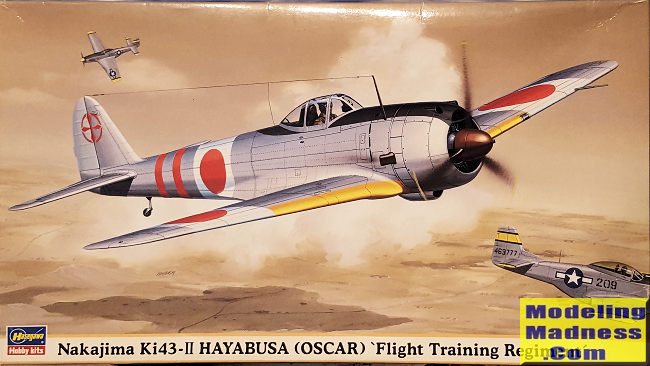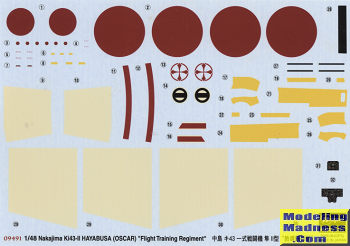
Hasegawa 1/48 Ki-43-II Hayabusa 'Flight Training Regiment'
|
KIT # |
09491 |
|
PRICE: |
2400 yen SRP |
|
DECALS: |
Two Aircraft |
|
REVIEWER: |
|
|
NOTES: |
2003 Limited Edition |

|
HISTORY |
The Ki-43 is to the Japanese Army what the A6M was to the Japanese Navy during WWII. It was the first modern, low winged, retractable landing gear fighter of either service. Both were designed with maneuverability as the major factor in their design. The result was that the aircraft were lacking in other areas that were considered just as important to other powers. They did not have adequate armor protection, and the Ki-43 had rather weak armament of twin 12.7mm machine guns, even compared to the A6M which also had two 20mm cannon. The Ki-43 also had very good range, but this was a result of the lightweight airframe construction and lack of heavy things like armor plating and self-sealing fuel tanks.
Initially the Army did not like the Ki-43 as it was not as maneuverable as the lighter and smaller fixed undercarriage Ki-27. However, it did have much superior range and the war in China required a longer ranged fighter. Despite not being considered maneuverable enough, Allied pilots who attempted to dogfight with the Ki-43 soon found themselves in trouble. Fortunately, the lack of heavy armament of the Oscar often saved the foolish Allied pilots. Despite the known shortcomings of the Ki-43, the type was continually modified and produced even after the type was obsolescent. Many were expended in suicide attacks near the end of the war. To my knowledge, only one example still remains.
|
THE KIT |
This kit depicts a later -II variant with the single ejector exhaust
aimed back towards the rear. Early -II Hayabusas had the same outward facing
exhaust as the -I. As a result, the cowl flaps are different. This and later
Ki-43s have a three blade prop. Also provided is the proper shorter wing tips
along with the proper cowling and oil cooler. While most of the sprues are the
same in all of Hasegawa's Ki-43 kits, this one includes those particular to the
version kitted.
Like the previous kit, this one uses polycaps for the prop and tail
wheel. The cockpit is the same and very well detailed. Also the same is the
deployed 'combat flaps' which were designed to improve maneuverability by
increasing the wing area when deployed. I do wish that Hasegawa had left them
molded in the bottom of the wing. I've looked at hundreds of images of this
plane over the decades and only one photo has ever shown these extended. That
was a derelict example left behind on one of the various fields in New Guinea. Unfortunately, to model them shut requires some
concerted grinding on both the flap and the flap well to get a good fit. A motor
tool will take care of this, but one does need to be careful that one does not
melt the plastic in the process.
 If you have read the
review or
preview of the earlier Ki-43-I, then this kit
will be no surprise to you. You will know that the detailing and fit of the kit
is generally excellent. So what I'll do with this preview is to concentrate on
what is different between the types.
If you have read the
review or
preview of the earlier Ki-43-I, then this kit
will be no surprise to you. You will know that the detailing and fit of the kit
is generally excellent. So what I'll do with this preview is to concentrate on
what is different between the types. Instructions are equally as
superb as before with the usual Gunze paint references. There are two markings options.
The first is the box art plane from the Hokota Flying School in mid 1944. Like
the other option, this plane is unpainted and carries white home defense bands
on the wings and fuselage. The other is with Kumagaya Flying School during the
same time period. While the decals are nicely printed, they are old school
Hasegawa where the whites are off-white. They are also fairly thick and will
need very hot water to perform the best. I'd recommend painting the white bands
and the yellow wing leading edge ID markings.
Instructions are equally as
superb as before with the usual Gunze paint references. There are two markings options.
The first is the box art plane from the Hokota Flying School in mid 1944. Like
the other option, this plane is unpainted and carries white home defense bands
on the wings and fuselage. The other is with Kumagaya Flying School during the
same time period. While the decals are nicely printed, they are old school
Hasegawa where the whites are off-white. They are also fairly thick and will
need very hot water to perform the best. I'd recommend painting the white bands
and the yellow wing leading edge ID markings.
|
CONCLUSIONS |
I am a real fan of the Ki-43 and have built quite a
few of them over the years. I never seem to tire of the different markings
options provided for the tails of these planes along with the camouflage schemes
worn by some. The Hasegawa kit is particularly nice and it will take some doing
to eclipse it. Even the Fine Molds kit is well worth building and may be easier
to find. While Hasegawa rarely repeats limited editions, the base kit is fairly
easy to locate if you don't mind getting it from overseas.
February 2021
Copyright ModelingMadness.com. All rights reserved.
If you would like your product reviewed fairly and fairly quickly, please
contact
the editor or see other details in the
Note to
Contributors.